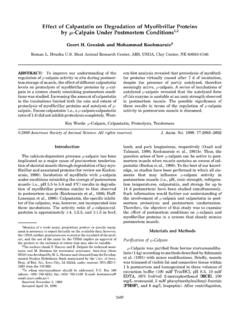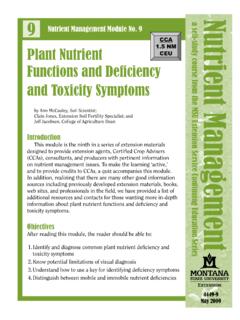Transcription of Concentrations of Anthocyanins in Common Foods in the ...
1 Concentrations of Anthocyanins in Common Foods in theUnited States and Estimation of Normal ConsumptionXIANLIWU, GARYR. BEECHER, JOANNEM. HOLDEN,#DAVIDB. HAYTOWITZ,#SUSANE. GEBHARDT,#ANDRONALDL. PRIOR*, USDA Arkansas Children s Nutrition Center, 1120 Marshall Street, Little Rock, Arkansas 72202, andFood Composition Laboratory and Nutrient Data Laboratory, Beltsville Human Nutrition Center,Agricultural Research Service, Department of Agriculture, 10300 Baltimore Avenue,Beltsville, Maryland 20705 Anthocyanins (ACNs) are water-soluble plant pigments that have important functions in plantphysiology as well as possible health effects. Over 100 Common Foods were screened for ACNs,and 24 of them were found to contain ACNs. Concentrations of total ACNs varied considerably to 1480 mg/100 g of fresh weight in gooseberry ( Careless variety) and chokeberry, only does the concentration vary, but the specific Anthocyanins present in Foods are also quitedifferent.
2 Only six Common aglycones, delphinidin, cyanidin, petunidin, pelargonidin, peonidin, andmalvidin, were found in all of these Foods . However, their sugar moieties and acylation patterns variedfrom food to food. Results from this study will add to the available data for the USDA Nutrient Databaseof flavonoids. On the basis of the concentration data and updated food intake data from NHANES2001-2002, the daily intake of ACNs is estimated to be mg/day/person in the United States. Ofthe different aglycones, cyanidin, delphinidin, and malvidin were estimated to contribute 45, 21, and15%, respectively, of the total ACN intake. Nonacylated contributed 77% compared to 23% fromacylated : Anthocyanin; concentration; daily intake; NHANESINTRODUCTIONA nthocyanins (ACNs) are water-soluble plant pigmentsresponsible for the blue, purple, and red color of many planttissues. They occur primarily as glycosides or acylglycosidesof their respective aglycone anthocyanidins (1).
3 Aglycones arerarely found in fresh plant materials. There are about 17anthocyanidins found in nature (1), whereas only 6 of them,cyanidin (Cy), delphinidin (Dp), petunidin (Pt), peonidin (Pn),pelargonidin (Pg), and malvidin (Mv), are ubiquitously distrib-uted (Figure 1). Thus far, over 600 naturally occurring ACNshave been reported (2,3), and they are known to vary in (1)the number and position of hydroxyl and methoxyl groups onthe basic anthocyanidin skeleton; (2) the identity, number, andpositions at which sugars are attached; and (3) the extent ofsugar acylation and the identity of the acylating agent (4).ACNs have important functions in plant physiology. Theyare believed to play a major role in both pollination and seeddispersal. Because of their intense color, Anthocyanins are alsoregarded as potential candidates for natural colorants in the foodindustry. Recently, increased attention has focused on theirpossible health effects.
4 ACNs have been shown to be strongantioxidants (5-7) and may exert a wide range of health benefitsthrough antioxidant or other mechanisms (8-16).From published data, we know that the content of total ACNsin Foods varies considerably. Not only does the concentration* Author to whom correspondence should be addressed USDA Arkansas Children s Nutrition Center. Food Composition Laboratory, Department of Agriculture.#Nutrient Data Laboratory, Department of structures of six naturally occurring Agric. Food ,54,4069 CCC: $ 2006 American Chemical SocietyPublished on Web 04/28/2006vary, but the specific ACNs present in Foods are also quitedifferent. The potential dietary intake of ACNs is among thegreatest of the various classes of flavonoids. Intake of ACNswas estimated to be as high as 185-215 mg/day/person in anearly paper (17). These data have been quoted extensively buthave limitations due to the lack of comprehensive data onanthocyanin content and daily intake and information onindividual Anthocyanins .
5 Accurate estimation of ACN contentin Foods and the daily intake is critical in food science, nutrition,and other related research fields. Recent research has shownthat Anthocyanins with different aglycones and sugar moietiesmay have quite different responses in terms of their bioavail-ability and potential health effects (16,18-21). Acylated ACNsmay behave quite differently from nonacylated ACNs in termsof their stability and bioavailability (22-25); it is not reasonableto consider all Anthocyanins as behaving in the same , knowledge regarding the Concentrations and daily intakeof specific Anthocyanins is objective of this study was to quantify Anthocyanins incommon Foods on the basis of their specific composition, whichhas been reported previously (26,27). All of the foodsconsidered in this study were obtained directly from on multiple occasions as described previously (28) andthus are representative of the Foods commonly consumed bythe population.
6 One of the major purposes of this study isto provide information for the USDA database of addition, an estimation of the daily intake of ACNs in theUnited States was made on the basis of our quantitative dataand results from the updated food intake survey, the NationalHealth and Nutrition Examination Survey (NHANES 2001-2002) (29).MATERIALS AND METHODSS tandards and of the 3-O- -glucosides ofpelargonidin, cyanidin, peonidin, delphinidin, petunidin, and malvidin(six mixed anthocyanin standard, HPLC grade) were obtained fromPolyphenols Laboratories (Sandnes, Norway). Formic acid was pur-chased from Aldrich (St. Louis, MO). All other solvents were purchasedfrom Fisher (Fair Lawn, NJ).Sampling Method and Sample sources andmethods of collection of food samples in this study were describedpreviously (28).Fruits and vegetables were sampled from retail outletsin 12 cities around the United States in two different seasons usingstatistically validated methods (30,31).
7 Approximately 3 lb of eachitem was randomly selected from bins in each retail outlet. Thesesamples were composited to form four regional composites: west (LosAngeles, CA; Vancouver, WA; and Longview, WA); central (Wheaton,IL; Conroe, TX; and Beaumont, TX); south (Mena, AR; Springfield,MO; and Franklin, TN); and northeast (Springfield, NJ; Canonsburg,PA; and Franklin, PA). Sweet cherries and red grapes were collectedin only one season from the same locations and composited in the samemanner. There were normally eight samples for each food item. Thesamples were collected and processed in the Food and AnalysisLaboratory Control Center, Department of Biochemistry of the VirginiaPolytechnic Institute and State University (Blacksburg, VA). Concordgrape freeze-dried powder was provided by Future Ceuticals (SantaRosa, CA). One of the strawberry samples was provided as a freeze-dried powder by the Oregon Strawberry Commission (OSC).
8 Blackbean, small red bean, red onion, and eggplant were purchased from alocal supermarket. Dry matter was determined using AOAC standard-ized methods [vacuum oven, ( )]. All fresh Foods werefreeze-dried and kept at-70 C until analyzed. The freeze-driedpowders were extracted using methanol/water/acetic acid (85:15 ,v/v, MeOH/H2O/HAc) as reported previously (32). The solutions fromthe extracted samples were then diluted with acidic methanol asnecessary to obtain Concentrations in a detectable range and filteredusing a m Teflon syringe filter (Cameo, MN) for ACN Analysis and Quantitation of analyses were performed on an HP 1100series HPLC (Hewlett-Packard, Palo Alto, CA) equipped with anautosampler/injector and diode array detector. A Zorbax StablebondAnalytical SB-C18column ( 250 mm, 5 m, Agilent Technologies,Table Screened for the Presence of Anthocyaninsafruitsvegetablesnuts and dried fruitsspicesother foodsapplesbartichokealmondsbasil leafbreadapricotasparagusBrazil nutschili powderbreakfast cerealsavocadobeans, blackbcashewscinnamonsnackbananasbeans,n avyhazelnutscloves, groundblackberrybbeans, pintomacadamiascurry powderapple sauceblueberrybbeans, red kidneypeanutsgarlic powderbaby foodscantaloupebeans, small redbpecansginger, groundchipscherriesbbeetspine nutsmustard seedchocolatechokeberrybbroccolipistachi osbonion powdernative American foodcranberrybcabbagesbwalnutsoregano leafjuice, grapefruitcurrant, blackbcarrotspaprikajuice, lemoncurrant, redbcauliflowerdatesparsleyjuice, limeelderberrybceleryfigspepperjuice, tomatogooseberrybcornprunespoppy seedjuice.)
9 V8 vegetablegrapefruitcucumberraisinsturmer icketchupgrapesbeggplantbmilkhoneydewlet tucesbpeanut butterkiwifruitonionsbricemangopeassalsa nectarinesbpepperstomato sauceorange, navelpotatoespeachesbpumpkinpearsred radishesbpineapplesspinachplumsbsweet potatoesraspberrybtomatoesstrawberrybtan gerineswatermelonsaFoods listed as only major Foods were found to contain Agric. Food Chem.,Vol. 54, No. 11, 2006Wu et Sun, MD) was used for separation. The experimental conditionswere described in our former papers (26,27).ACN identification in all of the Foods has been reported in ourprevious papers (26,27). Quantification of Anthocyanins followed theprocedure reported previously (32). The intra- and interassay CVs and , respectively. The limit of quantification for ACNs undercurrent experimental conditions was 10 ng. Calculations were madeon the basis of the freeze-dried forms, and then the data were convertedto a fresh weight (FW) basis for fresh fruits and vegetables.
10 Finalconcentrations were expressed as milligrams per 100 g of fresh weight(FW) for fresh fruits and vegetables and on an as is weight basis forbeans and nuts. ACN weights were based upon the total mass [aglycone+glycoside(s)].Estimation of ACN daily intake of ACNs was estimatedprimarily using dietary intake information from the National Healthand Nutrition Examination Survey (NHANES 2001-2002) (29).NHANES was conducted by the Department of Health and HumanService (HHS). It is a multistage, stratified area sample that isrepresentative of the civilian noninstitutionalized population of theUnited States. Data on average total Concentrations of ACNs in grapejuices were kindly provided by Dr. JoLynne Wightman from Welch s,in which 23 different brands of commercial grape juices were AND DISCUSSIONA nthocyanin Quantitation in of the im-portant roles ACNs play in the food industry and humannutrition, accurate quantification of ACNs is critical.












